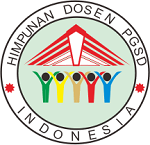Instructions for (Candidates) Author of JGK (Jurnal Guru Kita):
- Articles written for journals include the Education Sector, which relates to learning, research results, and community service. The manuscript is typed with the Microsoft Word program, Times New Roman letter, measuring 12 pts, with a space of 1.15; printed on A4 paper with a minimum length of 4 pages and a maximum of 20 pages, Margins: Top 3, left 4, bottom 3, right 3 and submitted in the form of a print-out of 1 copy along with the soft copy. Manuscripts are sent through the new submission section of the author's journal account that has registered or can be sent via email to the address: jurnalgurukita@unimed.ac.id
- Articles written in Indonesian or English. The article systematics are: title, author's name, author's institution, email, abstract along with keywords, introduction, methods, discussion, conclusions, and reference list.
- The article title cannot be more than 15 words. The title is printed with an inverted pyramid-shaped capital letter and is located in the middle, with a font size of 12 pts.
- The name of the author of the article is included without an academic degree, accompanied by the institution of origin and email address, and placed under the title of the article. In the case of a manuscript written by a team, the editor only deals with the main author or writer whose name is listed first. The main author must include an e-mail (e-mail).
- Abstracts and keywords are written in Indonesian and English. Times New Roman letters, measuring 10 pts, with spaces 1. The length of each abstract is a maximum of 100 words, while the number of keywords is 3-5 words. Abstract contains brief goals, methods and discussion.
- The introductory section contains the background, the context of the study, the results of the literature review, and the research objectives. All introductory sections are presented in an integrated form in paragraphs, with a length of 15-20% of the total length of the article.
- The section of the method contains a paragraph in the form of a study design, data sources, data collection techniques, and data analysis containing 10-15% of the total length of the article.
- The discussion section contains the results of the analysis, the presentation of material studies and comparison.
- The conclusions section contains research findings in the form of answers to research questions or in the form of the essence of the results of the discussion. Conclusions are presented in paragraph form.
- The referral list only contains the sources referred to, and all sources referred to must be listed in the referral list. A reference source of at least 80% in the form of a library of publications in the last 10 years. Referrals used are book sources, internet, research articles in journals or research reports (including theses, theses, dissertations). This journaled loaded article is recommended to be used as a reference.
- Referral and citing using the caged referral technique (last name, year). Inclusion of sources in direct quotations should be accompanied by a description of the page number of the place of origin of the quote. Example (Davis, 2003: 47).
- The list of references is prepared in a manner similar to the following example and sorted alphabetically and chronologically.
All references referred to in the text of the article must be listed in the Reference List section. The Reference List must contain reference literature originating from primary sources (scientific journals, amounting to a minimum of 80% of the entire reference list) published in the last 10 years. Writing a reference system in the article text and writing a bibliography is RECOMMENDED using the Mendeley or Zetero reference management application program. The writing format used in the Educational Journal is in accordance with the APA (American Psychological Association) format.
Guide to Writing a Reference List
Writing Reference Lists using reference management applications Mendeley or Zotero. The writing format used in the Educational Journal is in accordance with the APA (American Psychological Association) format.
Scientific Journals:
Yuangga, K. D., & Sunarsi, D. (2020). Pengembangan media dan strategi pembelajaran untuk mengatasi permasalahan pembelajaran jarak jauh di pandemi covid-19. JGK (Jurnal Guru Kita), 4(3), 51-58. https://doi.org/10.24114/jgk.v4i3.19472
Book:
Faisal & Lova, SM (2018). Thematic Learning in Elementary Schools. Medan: CV Harapan Smart.
Seminar Proceedings:
Angin, L. M. P., Sitanggang, A. K., Pandimun, D. F., & Ambarita, S. S. (2023, June). The Development of E-Book Learning Media in Class Management Course. In ICONSEIR 2022: Proceedings of the 4th International Conference on Science Education in The Industrial Revolution 4.0, ICONSEIR 2022, November 24th, 2022, Medan, Indonesia (p. 134). European Alliance for Innovation.
Dissertation/Thesis/Undergraduate Thesis:
Winara. (2022). Effect of Red Guava Juice and Tempeh Drinks, Submaximal Activity, and Fitness Level on Muscle Recovery. Doctoral Thesis. Semarang State University.
Website:
Arfah, Hamzah dan Khairina. (2023). Kepala Sekolah MTs yang Pukul 15 Siswi di Gresik Ditetapkan Tersangka. Kompas.com. https://surabaya.kompas.com/read/2023/01/07/163815778/kepala-sekolah-mts-yang-pukul-15-siswi-di-gresik-ditetapkan-tersangka
Government Documents:
Center for Educational Assessment, Research and Development Agency, Ministry of Education and Culture. (2019). Guide to Writing HOTS (Higher Order Thinking Skills) Questions. Jakarta: Center for Educational Assessment.
Government documents issued by publishers and without institutions:
Regulation of the Minister of Education and Culture of the Republic of Indonesia Number 3 of 2020 concerning National Higher Education Standards. (2020). Jakarta: Ministry of Education and Culture.
Articles/news in newspapers (without author's name):
Compass. December 8, 2019. Climate Crisis Sparks Social Movements, p 8.












